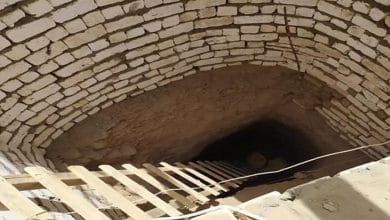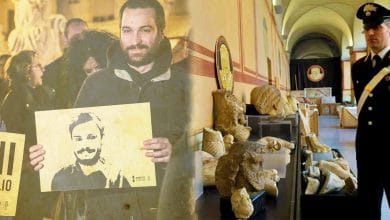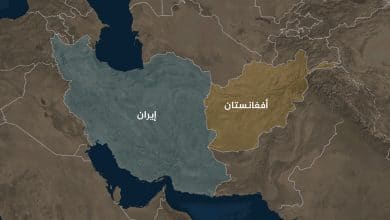
Repercussions of the 2013 coup on Egypt’s monuments
Repercussions of the 2013 coup on Egypt’s monuments
Abdel-Fattah Al-Sisi came to power through a bloody coup on July 3, 2013, which had its destructive effects on all the country’s institutions. However, Egypt’s monuments had the lion’s share of this collapse, which manifested in many negative aspects, most notably:
First: Growing rates of monument theft
After the coup d’état of July 3, 2013, incidents of robbery of antiquities increased significantly. In spite of the overwhelming evidence in this regard, yet officials have repeatedly claimed that the events of January Revolution, 2011, were behind the increase in the theft incidents, arguing that some 54 pieces were stolen from the Egyptian Museum in Cairo at the time (However, other officials said that more than 80 antiquities were stolen during the January Revolution events). Anyway, some officials later announced that 21 pieces were restored, but others said they have restored 29 pieces. At the same time, Former Minister of Antiquities Zahi Hawas said that the artifacts stolen from the museum were 18 pieces, including a statue made of the gilded wood for King Tutankhamun, and parts of another statue of Tutankhamun catching fish with a spear. In fact, these contradictions raise suspicions about the reality behind the statements of Egyptian officials, especially that they did not mention how these artifacts were restored, or who was behind stealing them?!
But observers confirm that theft of antiquities and attacks on archaeological sites have significantly spread after the July 3, 2013 coup. Former Egyptian Minister of Antiquities Mohamed Ibrahim announced on September 21, 2013 that the number of artifacts that were stolen since the January Revolution amounted to about 2000 pieces. Also, Al-Ahram, a state-owned newspaper, quoted Spectator, a British newspaper, as reporting that there is a remarkable growth in the looting of Egyptian antiquities. The Spectator report said thieves of artifacts sell the ancient treasures to collectors of antiques in London and the UAE. On May 30, 2014, a number of Egyptian experts reported that about 40% of the contents of antiquities warehouses are stolen almost on a daily basis in Egypt. Also, observers say that the January revolution was not accompanied by any acts of sabotage except after the artificial state of insecurity that was organized by the Egyptian police in collaboration with the military. As one of the Ministry of Antiquities employees, I can testy that during this period and until 30 June 2013, the violations by some citizens in the archaeological sites only came after they saw that the police had given up its role In the protection of monuments. Although archaeologists reported many violations at the time, to the competent authorities and police units of tourism and archaeology, however these units collectively did not move a finger towards these infringements under the pretext of security reasons until the coup took place on July 3, 2013, when the police began to remove infringements of only poor citizens.
Moreover, most museums were exposed to robbery. In August 2013, the Museum of Melloui, El-Menia, was robbed, leaving only 39 artifacts out of 1089. Even, rare archaeological mummies there were completely destroyed.
The Islamic Museum in Giza also was exposed to theft after the attack on the Cairo Security Directorate on January 24, 2014, where dozens of artifacts were stolen, including the “Abdul Malik bin Marwan Dinar”, and most of the museum’s 110,000 pieces were broken and maimed. Also, the Greek and Roman Museum in Alexandria was stolen on 25 April 2015.
We also wonder why thefts did not stop – but on the contrary increased – after the July 3 coup although putschists had claimed that they would protect Egypt and restore its security!
Most famous theft cases
– Three Germans and six Egyptians smuggle artifacts from the Great Pyramid: One of the most famous cases of theft of monuments took place in Egypt soon after the coup d’état of July 3, 2013, where three men, Dominique Goerlitz and Stefan Erdmann, were joined by a third Germans, aided by 6 Egyptians, committed the robbery. Three German researchers: Dominique Goerlitz, Stefan Erdmann, and a German filmmaker who accompanied them, were allowed to enter the inner chambers of the Great Pyramid at Giza normally off-limits to the public and restricted to authorized archaeologists and Egyptologists. The group reportedly took several items from the pyramids, including taking samples of a cartouche (identifying inscription) of the pharaoh Khufu, also known as Cheops. Goerlitz and Erdmann, who are not archaeologists but have instead been described as “hobbyists,” reportedly smuggled the artifacts out of the country in violation of strict antiquities laws, according to news reports. In addition to the three Germans, six Egyptians were held in connection with the case, including several guards and inspectors from the Egyptian Antiquities Ministry who allowed the men into the pyramid. The German government expressed outrage over the acts, and categorically stated the men were private citizens and not in any way affiliated with its German Archaeological Institute. Goerlitz and Erdmann acknowledged their acts, and even went so far as to post photographs and videos of themselves vandalizing the archaeological sites. The Egyptian Foreign Ministry announced on Mid-March, 2014 that some pieces, smuggled by Goerlitz, were seized in Germany and that the were working to return them to Egypt. However, none of the Egyptian officials of the Egyptian antiquities has ever said whether the artifacts were returned from Germany or not!
On 12 November 2014, the Egyptian press reported that the three German researchers along with the six Egyptians were sentenced to five years in prison on charges of damaging and stealing artifacts from the last remaining Wonder of the Ancient World – the Great Pyramid of Giza. Meanwhile, former Minister of Antiquities Zahi Hawass is reportedly being investigated regarding this incident. The Giza Criminal Court sentenced the nine defendants on Tuesday (November 12 2014) after it found them guilty of stealing a cartouche with a hieroglyphic inscription bearing the name of Pharaoh Khufu (Cheops). The three German defendants were not in Egypt at the time of the verdict, and were thus sentenced in absentia. The six Egyptians currently in detention include three employees of the Antiquities Ministry, two guards at the site of the pyramids, and a manager of a tourism company. All six were accused of facilitating the theft of antiquities. While this news was reported in state-owned media outlets on Tuesday and Wednesday, the Ministry of State for Antiquities has made no mention of this incident as of yet on their web page.
– Owner of a jewellery shop in Cairo attempting to smuggle antiquities abroad – April 2016: One of the most famous operations was also announced in April 2016, when a smuggling operation was foiled. The smuggling attempt was described as “the biggest smuggling operation in decades”. The owner of a jewellery shop was seized in Ain Shams, Cairo, while trying to smuggle 9,000 pieces out of the country.
– Customs officer and contractor arrested before selling 366 antiquities – August 2017. On August 17, 2017, a customs officer and a contractor were arrested with 366 antiquities before they sold them, one day after the smuggling of 52 antiquities in Minya governorate, including statues of three idols, on the same day as the Ministry of Antiquities The Egyptian Ministry of Culture said in a statement published on August 16, 2017, that it had lost 32,638 antiquities over more than 50 years. Recent inventory works!
– The latest famous theft was announced by the Kuwaiti customs authorities on the seventh of March 2018 when they seized a smuggled Egyptian coffin of about two meters long, expertly concealed inside a sofa at the Kuwait Airways cargo terminal, after leaving Cairo airport!! Kuwaiti archaeology experts then said that they are “almost certain” that a stone coffin lid, dating back to the Pharaohs era, was found within a sofa. The antique is 170 centimeters long, looks like a statue with an elaborate headdress, and is carved in stone.
Al-Bawaba News reported on August 21, 2017, that a resident of a village in Akhmim, Sohag, said, “The search for antiquities is no longer a hobby or a temporary job performed by a person who believes that there is a cemetery or an archaeological site located below his house,” adding that “It has become an organized activity such as that of mafia gangs: some specialize in exploration of sites where there may be antiquities; and others, working to promote their discoveries.”
The incident of this coffin prompts me to emphasize my clear and permanent view that the Egyptian antiquities cannot be smuggled out of the country except through an official. The people who are rushing to dig and excavate – even if they do not have a flair of their favorites during the excavation – The slightest doubt is that they will not be able to dispose of the pieces of antiquities or work on smuggling them out of Egypt except through an official, whatever the status of this official is. What I want to emphasize here is that no artefact could leave Egypt without help from officials.
Second: Coup authorities and transfer of Egyptian antiquities to the Louvre Abu Dhabi
In spite of all that has been raised about this issue that has preoccupied public opinion for some time, the suspicious silence of the coup d’état authorities towards the Louvre Abu Dhabi Museum in November 2017 raised suspicions when the United Arab Emirates inaugurated the museum, which included 55 buildings, and contained more than 25 thousand pieces of antiquities, including many pieces of Egyptian artifacts.
It also raised doubts about the involvement of the coup authority in this matter, when authorities suspended the publishing of an article by the Journalist Nasser Salameh titled “Report to the Attorney General” in Al-Masry Al-Youm newspaper., prompting him to publish it on his Facebook page, 2017, revealing that the scandal at an early time, before the UAE exhibited the Egyptian artifacts in its museum, and accused the UAE of stealing Egypt’s monuments, wondering: When were these artifacts smuggled out of Egypt, especially that there were coffins full large size among them?
However, a negative response by the Egyptian Ministry of Antiquities came in a statement quoted by news websites on September 18, 2017, saying that “Egypt has not sent any Egyptian antiquities for display in the Louvre Abu Dhabi museum or in the UAE in general for more than 20 year”.
It is noteworthy that construction of the Louvre Abu Dhabi Museum started in 2007 at a cost of 100 million euros. Also, a deal was reached between the UAE and France to display Egyptian antiquities and other monuments in 2007, amounting to 1.3 billion dollars, of which Egypt received nothing.
Third: Rent of Egypt’s monuments to the UAE
The story of renting Egyptian monuments was reported by “Al-Mesaa, an Egyptian government owned newspaper, on December 30 2013 on an offer extended by an Emirati company to rent the monuments of the archaeological sites of Salah al-Din and Qaytibay citadels, and Luxor temples. The newspaper pointed out that an official at the Antiquities Ministry confirmed that the project is a quick solution to the current financial crisis.
The report said that the newspaper learned from informed sources at the Ministry of Antiquities that some Gulf countries offered to rent some of the archaeological sites in Egypt, such as the area of Salah al-Din Citadel in Cairo and the Qaitbay Castle area of Alexandria as well as the temples of Luxor, where the UAE ProAct World company sent a letter – in which it tried to hide being an Emirati company by stating that it is an Egyptian and regional company – to the Ministry of Antiquities including its offer.
According to the newspaper, th Ministry of Antiquities passed the project has been passed through the UAE company through a plan called “The right to use famous archaeological sites in Egypt” in favour of major international companies such as Proctel, Gamble, Nokia and Etisalat, as a quick solution to the financial crisis experienced by Egypt.
Minister of Antiquities Dr. Mohammed Ibrahim, admitted at the time that the UAE offer to develop archaeological sites does not include renting them, adding that the ministry received a letter from one of the UAE private companies wishing to develop some Islamic and Egyptian archaeological sites and equipped them with the most advanced means of technology.
On January 11, 2008, head of the Egyptian Company of Sound and Light, Sameh Saad, announced that Prisme International will manage the Giza pyramids for 20 years, provided that it would develop the area and pump $ 50 million. The reports were based on a 2015 agreement that was signed between the state-run Egyptian Company of Light and Sound (ECLS), currently assigned to operate night shows at the Giza Pyramids, and an Emirati company called Prisme International. Sameh Saad said, “The 2015 agreement stipulated that Prisme International will be responsible for the upgrading process of the lighting and sound systems used to operate the night shows at the Giza Pyramids. It will also share profits of the show with the ECLS for 20 years [but] this does not mean that it will administrate the Giza Pyramids.” However, Saad noted that Prisme international UAE is now under the administration of the Egyptian company Orascom that is owned by Egyptian business tycoon Naguib Sawiris, adding that Orascom has the majority of shares of Prisme international UAE, meaning that the deal was made between two Egyptian companies. “The partnership is now with an Egyptian company not Emirati company. The agreement has now been activated after the company was subjected to Egyptian administration, and in both cases, the company is not administrating. It only develops sound and light techniques and will operate them for 20 years under the supervision of the Egyptian Company of Light and Sound. Both companies will share the profits,” Saad added.
Fourth: Egypt’s monuments sold in public auctions
On October 9, 2013,”Beydon” an Israeli website specializing in e-marketing advertised original Egyptian antiques at various prices. Among the antiquities exhibited were a set of bronze statues of Osiris dating back to 342 BC, and a beaded mask that dates back to the year 1650 BC, as well as other precious antiquities.
Although a statement by the Egyptian Ministry of Antiquities announced that the ministry would move on the international level immediately after the exhibition, however, none mentioned how these monuments were smuggled out of Egypt. On 20 November, Minister of Antiquities Dr. Khaled Anani declared in Parliament that he and his ministry were able to restore two artifacts from Israel, the first of its kind since 1996, although the Jerusalem auction offered to sell 126 pharaonic artifacts!!
More recently, on March 25, 2018, Al-Shorouq reported a story titled: “In Pictures: 27 Rare Egyptian Antiquities Sold in Public Auction in New York”, revealing that 27 pieces of unique Egyptian antiquities would be sold at auction on 18 April 2018. Christie’s website also announced that “it is auctioning off 27 Ancient Egyptian artifacts in New York on April 18. The website said that the pieces on display included a rare statue of Sekhem-ankh-Ptah, an ancient Egyptian high official who lived during the Old Kingdom period (2389-2255 B.C.), as well as mummy masks from the Roman period. Some pieces of Egyptian antiquities for sale at this auction was estimated at more than one million and 500 thousand US dollars!!
However, Shaaban Abdel-Gawad, the Supervisor General of the Antiquities Repatriation Department within the Egyptian Ministry of Antiquities, only told the press shamelessly that his ministry is aware that these pieces will be auctioned off in New York on April 18! The official said that his ministry was verifying the ownership documents of these pieces in order to ascertain the way they were taken out of Egypt. This raises suspicions around the ministry officials – who still seek to justify continuation of these auctions and smuggling of Egypt’s antiques.
Conclusion
The aforementioned presentation shows some of the repercussions of the military coup of July 3, 2013 on Egypt’s antiquities, which represents the country’s history and civilization, and provides foreign currency revenues that have a profound impact on our staggering economy. These repercussions included escalating rates of thefts, turning a blind eye on Egyptian monuments that are smuggled out of the country to be sold publicly in global auctions, and renting Egypt’s historic sites to regional supporters of the military coup.




